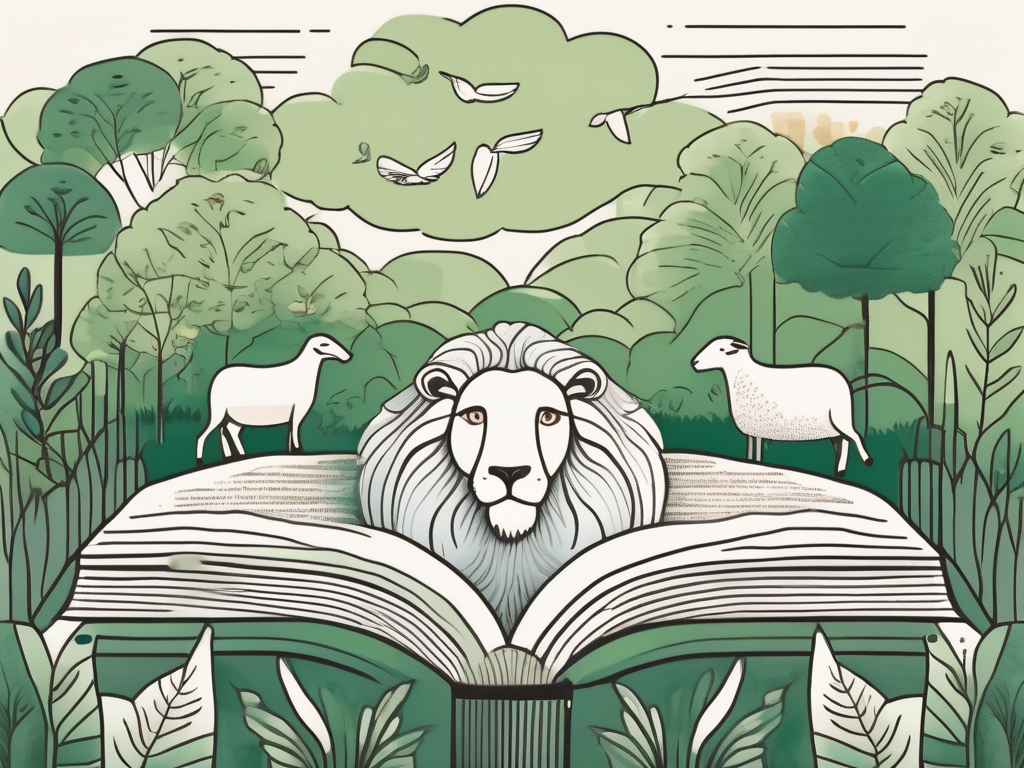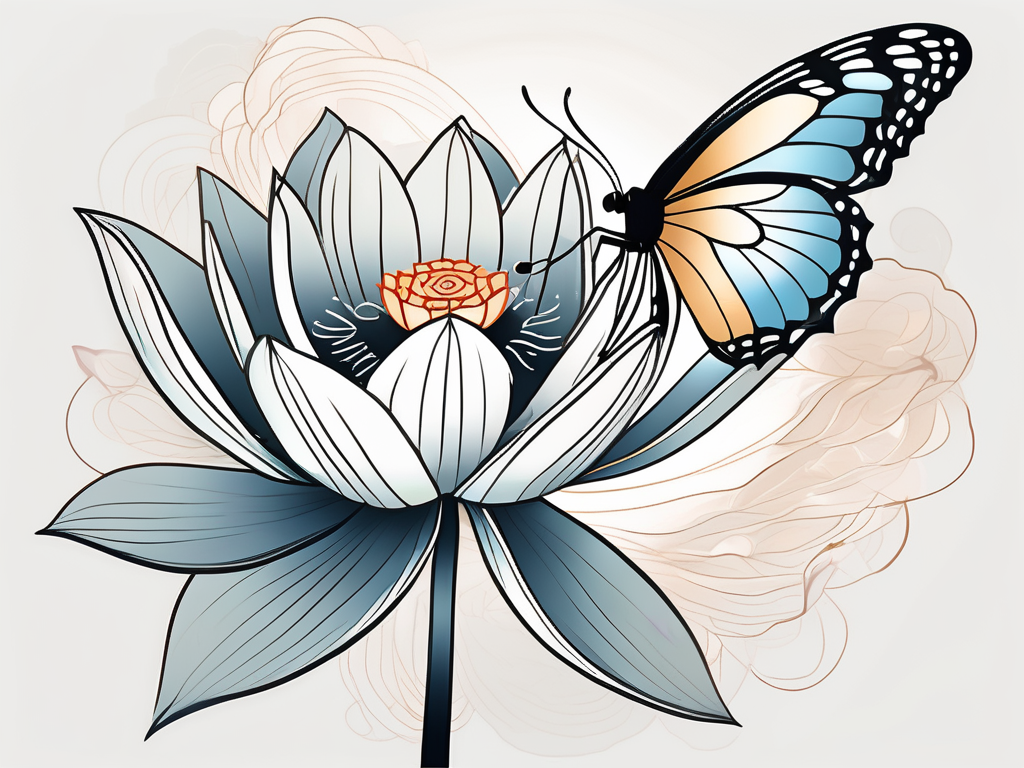Buddhism is an ancient philosophy that has captured the minds and hearts of millions around the world. Its teachings offer profound insights into the nature of existence and provide guidance for living a meaningful life. One of the fascinating aspects of Buddhism is its concept of reincarnation, which includes the possibility of being reborn as an animal. In this article, we will explore the key principles of Buddhism, delve into the belief in reincarnation, and examine the role of animals within the teachings. Finally, we will reflect on the implications of reincarnation as an animal and how one can overcome the cycle of rebirth.
Understanding the Basics of Buddhism
Buddhism is not just a religion, but a way of life encompassing both spiritual and philosophical dimensions. At its core are the Four Noble Truths and the Eightfold Path, which provide a roadmap for attaining enlightenment.
Originating in ancient India, Buddhism has spread across the globe, influencing millions of people with its teachings. It offers a unique perspective on life, emphasizing the importance of self-reflection and personal growth.
The Four Noble Truths
The Four Noble Truths are the foundation of Buddhist teachings. They are:
- Life is suffering.
- Suffering arises from attachment and desire.
- Suffering can cease by letting go of attachment and desire.
- The Eightfold Path leads to the cessation of suffering.
This truth acknowledges the presence of suffering in human existence. It recognizes that life is filled with various forms of pain, including physical, emotional, and psychological.
Buddhism teaches that suffering is a result of our attachments and desires. When we cling to things or crave for what we don’t have, we create a cycle of dissatisfaction and discontentment.
By understanding the impermanence of all things and cultivating a mindset of non-attachment, individuals can break free from the cycle of suffering. Letting go of desires and expectations allows for a greater sense of peace and contentment.
The Eightfold Path serves as a guide for individuals seeking liberation from suffering. It provides a comprehensive framework for ethical conduct, mental development, and spiritual growth.
These truths emphasize the impermanence and interconnectedness of all things, urging individuals to seek liberation from suffering. They invite practitioners to examine their own lives and develop a deeper understanding of the nature of existence.
The Eightfold Path
The Eightfold Path outlines the ethical, mental, and spiritual practices that lead to enlightenment. It consists of the following components:
- Right Understanding
- Right Intention
- Right Speech
- Right Action
- Right Livelihood
- Right Effort
- Right Mindfulness
- Right Concentration
Right Understanding involves developing a clear comprehension of the Four Noble Truths and the nature of reality. It encourages individuals to see beyond surface-level appearances and gain insight into the true nature of existence.
Right Intention focuses on cultivating wholesome intentions and motivations. It encourages individuals to let go of harmful thoughts and desires and instead cultivate compassion, kindness, and generosity.
Right Speech emphasizes the importance of using words wisely and skillfully. It encourages individuals to speak truthfully, avoid harmful speech, gossip, and divisive language, and instead use words to promote harmony and understanding.
Right Action involves engaging in actions that are ethical and beneficial. It encourages individuals to refrain from harming others, stealing, engaging in sexual misconduct, and instead cultivate actions that promote well-being and harmony.
Right Livelihood emphasizes the importance of earning a living in a way that is ethical and aligned with one’s values. It encourages individuals to choose occupations that do not cause harm to others and contribute positively to society.
Right Effort involves cultivating a diligent and persistent attitude towards spiritual practice. It encourages individuals to make a continuous effort to let go of unwholesome thoughts and behaviors and cultivate wholesome ones.
Right Mindfulness is the practice of being fully present and aware in the present moment. It involves observing one’s thoughts, feelings, and sensations without judgment, cultivating a deep sense of self-awareness and clarity.
Right Concentration involves developing focused and undistracted mental states through meditation and other contemplative practices. It allows individuals to cultivate deep levels of concentration and insight, leading to profound spiritual experiences.
By cultivating these qualities, individuals can find inner peace and harmony with the world around them. The Eightfold Path serves as a practical guide for integrating Buddhist principles into daily life, enabling practitioners to navigate the challenges of existence with wisdom and compassion.
The Buddhist Belief in Reincarnation
Central to Buddhism is the notion of reincarnation, the continuous cycle of birth, death, and rebirth. Reincarnation is governed by the concepts of the cycle of samsara and karma.
Reincarnation, or the belief in the transmigration of souls, has been a fundamental aspect of Buddhist philosophy for centuries. It is a concept that offers a profound understanding of the nature of existence and the potential for spiritual growth.
Within the Buddhist tradition, the cycle of samsara is a fundamental concept that explains the perpetual cycle of existence. According to this belief, beings are trapped in the realms of desire, form, and formlessness, continuously moving from one life to another. This cycle is characterized by suffering and dissatisfaction, as individuals are bound by their desires and attachments.
The goal of Buddhism is to break free from the cycle of samsara and achieve liberation, known as nirvana. Nirvana is the ultimate state of enlightenment and freedom from suffering. It is the cessation of the cycle of birth, death, and rebirth, and the attainment of perfect peace and wisdom.
The Cycle of Samsara
Samsara refers to the perpetual cycle of existence, where beings are trapped in the realms of desire, form, and formlessness. This concept is deeply rooted in the understanding that life is inherently impermanent and subject to change. It is the recognition that all conditioned phenomena are subject to birth, decay, and death.
Within the cycle of samsara, beings are driven by their desires and attachments, constantly seeking happiness and fulfillment in external sources. However, this pursuit often leads to suffering and dissatisfaction, as these desires are insatiable and transient in nature.
According to Buddhist teachings, the cycle of samsara is perpetuated by the three poisons: ignorance, attachment, and aversion. Ignorance refers to the lack of understanding of the true nature of reality, attachment is the clinging to desires and attachments, and aversion is the rejection and avoidance of unpleasant experiences.
Breaking free from the cycle of samsara requires a deep understanding of the nature of reality and the cultivation of wisdom and compassion. It involves recognizing the impermanence and interconnectedness of all things and letting go of attachments and desires.
Karma and Its Impact on Rebirth
Karma is the law of cause and effect, dictating that our actions have consequences. In the context of reincarnation, karma determines the quality of our future lives. Positive actions lead to a higher form of rebirth, while negative actions can result in being reborn in lower forms, including animals.
According to Buddhist teachings, karma is not a form of punishment or reward, but rather a natural law that governs the cycle of samsara. It is the accumulation of intentional actions, both positive and negative, that shape our future experiences.
Positive actions, such as acts of kindness, generosity, and compassion, create positive karma and lead to a favorable rebirth. On the other hand, negative actions, such as harming others, greed, and hatred, create negative karma and result in a lower form of rebirth.
It is important to note that karma is not determined solely by our actions in this lifetime but is believed to be influenced by our actions in past lives as well. This understanding emphasizes the interconnectedness of all beings and the responsibility we have for our own actions.
By cultivating virtuous qualities and engaging in wholesome actions, Buddhists aim to accumulate positive karma and create the conditions for a favorable rebirth. Ultimately, the goal is to break free from the cycle of samsara and attain liberation from suffering.
The Role of Animals in Buddhism
Animals play a significant role in Buddhist teachings, symbolizing various qualities and offering valuable lessons for practitioners. Throughout Buddhist literature, animals are often used as symbols to convey important moral and spiritual insights. These symbolic representations provide practitioners with a deeper understanding of the teachings and encourage them to cultivate specific qualities in their own lives.
Symbolism of Animals in Buddhist Teachings
Animals hold a special place in Buddhist symbolism, representing a wide range of virtues and characteristics. For instance, the elephant is often seen as a symbol of strength and wisdom. In Buddhist literature, the elephant’s immense physical power is likened to the strength of one’s mind and the wisdom gained through meditation and mindfulness.
Similarly, the snake is frequently used as a symbol in Buddhist teachings, representing cunning and transformation. Just as a snake sheds its skin, practitioners are encouraged to let go of their attachments and transform themselves through self-reflection and spiritual growth.
Other animals, such as the lion, peacock, and deer, also hold significant symbolism in Buddhism. The lion, known for its courage and fearlessness, represents the strength needed to overcome obstacles on the spiritual path. The peacock, with its vibrant and captivating feathers, symbolizes beauty and spiritual awakening. The deer, often depicted in Buddhist art, represents gentleness and a peaceful nature.
The Five Precepts and Treatment of Animals
Central to Buddhist teachings is the emphasis on compassion and non-harm towards all living beings. The Five Precepts, a set of ethical guidelines for practitioners, includes refraining from harming or killing animals. This reflects the Buddhist belief in the interconnectedness and inherent value of all life forms.
By adhering to the Five Precepts, practitioners strive to cultivate a deep sense of respect and compassion for animals. This extends not only to domesticated animals but also to those in the wild. Buddhists are encouraged to view animals as sentient beings deserving of kindness and protection.
Furthermore, the Buddhist teachings emphasize the importance of developing empathy towards animals. Practitioners are encouraged to reflect on the suffering that animals endure due to human actions, such as deforestation, pollution, and animal exploitation. This reflection serves as a reminder to live in harmony with nature and to minimize harm to all living beings.
In Buddhist communities, there are often initiatives and organizations dedicated to the welfare and protection of animals. These initiatives aim to raise awareness about animal rights and promote ethical practices in relation to animals. By actively engaging in such initiatives, Buddhists seek to embody the teachings of compassion and non-harm in their daily lives.
Overall, animals hold a significant place in Buddhism, serving as powerful symbols and reminders of important spiritual principles. Through their symbolism and the ethical guidelines of the Five Precepts, animals play a crucial role in guiding practitioners towards a compassionate and mindful way of life.
Reincarnation as an Animal: A Buddhist Perspective
Being reborn as an animal is a possibility within the framework of Buddhist philosophy. But what does it involve, and what are the implications?
The Process of Rebirth into the Animal Realm
In Buddhism, reincarnation as an animal is seen as a result of negative actions and attachments in previous lives. It is believed that one’s actions and consciousness determine the specific animal form one will be reborn into.
The Implications of Animal Rebirth
Buddhists see the animal realm as one of suffering, where beings are driven by instincts and primal desires. While animals can exhibit kindness and love, they lack the capacity for self-awareness and spiritual growth that humans possess.
Overcoming the Cycle of Rebirth
Ultimately, the aim of Buddhism is to transcend the cycle of rebirth and attain enlightenment or nirvana, a state of liberation, peace, and wisdom.
Achieving Nirvana
Nirvana is the ultimate goal in Buddhism, representing liberation from suffering and the cycle of rebirth. It is a state of pure consciousness, where attachments and desires have been extinguished.
The Path to Enlightenment
The path to enlightenment lies in following the Eightfold Path and cultivating virtues such as compassion, wisdom, and mindfulness. By practicing meditation and self-reflection, individuals can gradually overcome the illusions and attachments that keep them bound to the cycle of samsara.
In conclusion, the concept of Buddhism offers profound insights into the nature of existence and provides a path towards liberation from suffering. Reincarnation as an animal is an integral part of this philosophy, highlighting the significance of our actions and the interconnectedness of all living beings. By nurturing compassion, cultivating virtues, and seeking enlightenment, individuals can overcome the cycle of rebirth and attain ultimate liberation. Let us embrace the wisdom of Buddhism and strive for a life of purpose and harmony.












